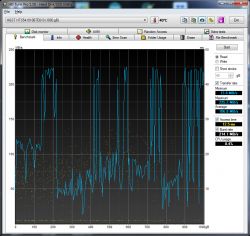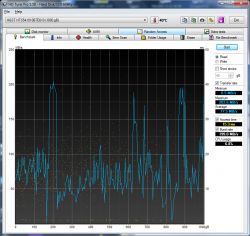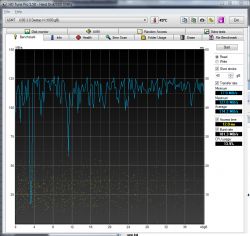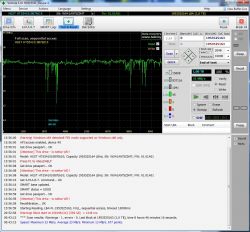Hello.
If the topic turns out to be useful / needed, I will pin it somewhere at the top, and if not, it will slide down to other pages in a moment, along with other posts. As long as the manufacturers do not stop being "ashamed" of this technology and start marking the drives using it in the documentation, such a list may make some sense.
I tried to confirm most of the models in the documentation, a few entries are unconfirmed (based on, among others, performance tests and high density of writing to the platter, usually accompanied by a large cache buffer).
SMR technology is nothing very new, but for some time now you have come across a cheap disk. This post is not intended to be a technical elaboration on this technology, if someone is interested in the details of its operation, he will certainly find a lot of articles on the web on this topic. In short, SMR drives allow you to get more capacities, but the price is sacrificing performance.
In general, these disks are suitable as a data storage, where writes are not made non-stop (due to the data writing mechanism). They are not especially suitable for RAID arrays and for applications requiring high write performance (some imperfections at very high load will also ricochet read speed).
Manufacturers very scrupulously hide the fact that they use SMR technology in disks, so I will try to list disks that are known to use this technology (or there are indications that they can use it).
Seagate 3.5 "
Seagate 2.5 "
Toshiba 3.5 "
Toshiba 2.5"
Western Digital 3.5"
Western Digital 2.5 "
Western Digital 2.5 "USB
Hitachi (Western Digital) 3.5 "
The current WD series (as of April 2020) look like this (click the picture to enlarge):

Source: Western Digital RED NAS Blog, post 22/04/2020, https://blog.westerndigital.com/wd-red-nas-drives/
The technology used in current Seagate drives: https://www.seagate.com/en/pl/internal-hard-drives/cmr-smr-list/
Sources:
I am aware that this list is far from complete .
If you find other disks with more or less confirmed use of SMR technology - write in the answers, providing links to information sources or at least information indicating that such a disk has a good chance to use this technology (for example, the recording density of 2TB / plate).
Also, if you find information that reliably confirms that the disk on the list is not an SMR disk - it is also worth including such information.
At this point, most drives are "sure" - WD drives are confirmed on their blog, Toshiba drives are confirmed with Toshiba's representative to another portal, and most Seagate drives are endorsed from their catalog notes, but there are also a few drives placed on a legitimate basis suspicions (as indicated in the notes). Most of the sources are presented in the spoiler above.
If the topic turns out to be useful / needed, I will pin it somewhere at the top, and if not, it will slide down to other pages in a moment, along with other posts. As long as the manufacturers do not stop being "ashamed" of this technology and start marking the drives using it in the documentation, such a list may make some sense.
I tried to confirm most of the models in the documentation, a few entries are unconfirmed (based on, among others, performance tests and high density of writing to the platter, usually accompanied by a large cache buffer).
SMR technology is nothing very new, but for some time now you have come across a cheap disk. This post is not intended to be a technical elaboration on this technology, if someone is interested in the details of its operation, he will certainly find a lot of articles on the web on this topic. In short, SMR drives allow you to get more capacities, but the price is sacrificing performance.
In general, these disks are suitable as a data storage, where writes are not made non-stop (due to the data writing mechanism). They are not especially suitable for RAID arrays and for applications requiring high write performance (some imperfections at very high load will also ricochet read speed).
Manufacturers very scrupulously hide the fact that they use SMR technology in disks, so I will try to list disks that are known to use this technology (or there are indications that they can use it).
Seagate 3.5 "
Spoiler:
| Series | Model | Capacity | Remarks |
| Archive HDD | ST5000AS0011 | 5 TB | |
| Archive HDD | ST8000AS0022 | 8 TB | |
| Archive HDD v2 | ST6000AS0002 | 6 TB | |
| Archive HDD v2 | ST8000AS0002 | 8 TB | |
| Archive HDD Secure | ST5000AS0001 | 5 TB | |
| Archive HDD v2 Secure | ST6000AS0012 | 6 TB | |
| Archive HDD v2 Secure | ST8000AS0012 | 8 TB | |
| Barracuda Compute | ST2000DM005 | 2 TB | |
| Barracuda Compute | ST2000DM008 | 2 TB | |
| Barracuda Compute | ST3000DM007 | 3 TB | |
| Barracuda Compute | ST4000DM004 | 4 TB | |
| Barracuda Compute | ST6000DM003 | 6 TB | |
| Barracuda Compute | ST8000DM004 | 8 TB | |
| Desktop HDD | ST5000DM000 | 5 TB | unconfirmed / suspicious |
| Exos 5E8 | ST8000AS0003 | 8 TB |
Seagate 2.5 "
Spoiler:
| Series | Model | Capacity | Remarks |
| Barracuda Compute | ST500LM030 | 0.5 TB | |
| Barracuda Compute | ST1000LM048 | 1 TB | |
| Barracuda Compute | ST2000LM015 | 2 TB | |
| Mobile | ST1000LM035 | 1 TB | |
| Mobile | ST2000LM007 | 2 TB | |
| Mobile Secure | ST1000LM037 | 1 TB | |
| Mobile Secure | ST2000LM009 | 2 TB | |
| Mobile Secure FIPS | ST1000LM038 | 1 TB | |
| Mobile Secure FIPS | ST2000LM010 | 2 TB |
Toshiba 3.5 "
Spoiler:
| Series | Model | Capacity | Remarks |
| P300 | HDWD220UZSVA | 2 TB | Thanks for the info @KodIT |
| P300 | HDWD220EZSTA | 2 TB | |
| P300 | HDWD240UZSVA | 4 TB | |
| P300 | HDWD240EZSTA | 4 TB | |
| P300 | HDWD260UZSVA | 6 TB | |
| P300 | HDWD260EZSTA | 6 TB | |
| DT02 | DT02ABA400 | 4 TB | |
| DT02 | DT02ABA600 | 6 TB | |
| DT02-V | DT02ABA400V | 4 TB | |
| DT02-V | DT02ABA600V | 6 TB |
Toshiba 2.5"
Spoiler:
| Seria | Model | Pojemność | Uwagi |
| L200 Slim Bulk | HDWL110UZSVA | 1 TB | |
| L200 Slim Retail | HDWL110EZSTA | 1 TB | |
| L200 Bulk | HDWJ110UZSVA | 1 TB | |
| L200 Retail | HDWJ110EZSTA | 1 TB | |
| L200 Bulk | HDWL120UZSVA | 2 TB | |
| L200 Retail | HDWL120EZSTA | 2 TB | |
| MQ04 | MQ04ABF100 | 1 TB | |
| MQ04 | MQ04ABD200 | 2 TB |
Western Digital 3.5"
Spoiler:
| Seria | Model | Pojemność | Uwagi |
| Red | WD20EFAX | 2 TB | |
| Red | WD30EFAX | 3 TB | |
| Red | WD40EFAX | 4 TB | |
| Red | WD60EFAX | 6 TB | |
| Blue | WD20EZAZ | 2 TB | |
| Blue | WD60EZAZ | 6 TB |
Western Digital 2.5 "
Spoiler:
| Series | Model | Capacity | Remarks |
| Black | WD10SPSX | 1 TB | |
| Blue | WD9000LPZX | 0.9 TB | Very likely |
| Blue | WD10SPWX | 1 TB | Very likely |
| Blue | WD10SPZX | 1 TB | |
| Blue | WD20SPZX | 2 TB | |
| Blue 15mm | WD30NPZZ | 3 TB | Very likely |
| Blue 15mm | WD40NPZZ | 4 TB | Very likely |
Western Digital 2.5 "USB
Spoiler:
| Series | Model | Capacity | Uwagi |
| Blue USB | WD10SMZW | 1 TB | |
| Blue USB-C | WD10SMZM | 1 TB | |
| Blue USB AES | WD10SDZW | 1 TB | |
| Blue USB-C AES | WD10SDZM | 1 TB | |
| Blue USB | WD20SMZW | 2 TB | |
| Blue USB-C | WD20SMZM | 2 TB | |
| Blue USB AES | WD20SDZW | 2 TB | |
| Blue USB-C AES | WD20SDZM | 2 TB | |
| Blue 15mm USB | WD30NMZW | 3 TB | Very likely |
| Blue 15mm USB-C | WD40NMZM | 4 TB | Very likely |
| Blue 15mm USB | WD40NMZW | 4 TB | Very likely |
| Blue 15mm USB | WD50NMZW | 5 TB | Very likely |
| Blue 15mm USB AES | WD50NDZW | 5 TB | Very likely |
Hitachi (Western Digital) 3.5 "
Spoiler:
| Series | Model | Capacity | Remarks |
| Ultrastar DC HC620 | HSH721414ALE6M0 | 14 TB | |
| Ultrastar DC HC620 | HSH721415ALE6M0 | 15 TB | |
| Ultrastar DC HC620 | HSH721414ALE6M4 | 14 TB | |
| Ultrastar DC HC620 | HSH721415ALE6M0 | 15 TB | |
| Ultrastar DC HC620 | HSH721414ALN6M0 | 14 TB | |
| Ultrastar DC HC620 | HSH721415ALN6M0 | 15 TB | |
| Ultrastar DC HC620 | HSH721414ALN6M4 | 14 TB | |
| Ultrastar DC HC620 | HSH721415ALN6M4 | 15 TB | |
| Ultrastar DC HC620 SAS | HSH721414AL52M0 | 14 TB | |
| Ultrastar DC HC620 SAS | HSH721415AL52M0 | 15 TB | |
| Ultrastar DC HC620 SAS | HSH721414AL52M4 | 14 TB | |
| Ultrastar DC HC620 SAS | HSH721415AL52M0 | 15 TB | |
| Ultrastar DC HC620 SAS | HSH721414AL42M0 | 14 TB | |
| Ultrastar DC HC620 SAS | HSH721415AL42M0 | 15 TB | |
| Ultrastar DC HC620 SAS | HSH721414AL42M4 | 14 TB | |
| Ultrastar DC HC620 SAS | HSH721415AL42M4 | 15 TB | |
| Ultrastar DC HC650 | TBD | 20 TB | |
| Ultrastar DC HC650 SAS | TBD | 20 TB |
The current WD series (as of April 2020) look like this (click the picture to enlarge):

Source: Western Digital RED NAS Blog, post 22/04/2020, https://blog.westerndigital.com/wd-red-nas-drives/
The technology used in current Seagate drives: https://www.seagate.com/en/pl/internal-hard-drives/cmr-smr-list/
Sources:
Spoiler:
Seagate Archive: https://www.seagate.com/www-content/product-c...seagate-archive-hdd/en-us/docs/100795782a.pdf
Seagate Archive, Archive v2: https://www.seagate.com/www-content/product-c...ve-hdd/en-us/docs/archive-hdd-dS1834-3-1411en. pdf
Seagate Exos 5E8: https://www.seagate.com/files/www-content/datasheets/pdfs/exos-5e8DS1954-2-1712US-en_US.pdf
Seagate Barracuda Compute 2.5 ": https://www.seagate.com/www-content/product-c...op-fam/barracuda_25/en-us/docs/100807728c.pdf
Seagate Barracuda Compute 3.5 ": https://www.seagate.com/www-content/datasheets/pdfs/3-5-barracudaDS1900-14-2007GB-en_GB.pdf
Seagate Mobile: https://www.seagate.com/www-content/datasheets/pdfs/mobile-hddDS1861-1-1602-pl_PL.pdf
Toshiba: https://toshiba.semicon-storage.com/ap-en/com...s/news-topics/2020/04/storage-20200428-1.html
Toshiba P300: https://www.toshiba-storage.com/en/products/toshiba-internal-hard-drives-p300/
WD: https://blog.westerndigital.com/wp-content/uploads/2020/04/2020_04_22_WD_SMR_SKUs_1Slide.pdf
WD Ultrastar DC HC620: https://documents.westerndigital.com/content/...-center-drives/ultrastar-dc-hc600-series/data -sheet-ultrastar-dc-hc620.pdf
Seagate Archive: https://www.seagate.com/www-content/product-c...seagate-archive-hdd/en-us/docs/100795782a.pdf
Seagate Archive, Archive v2: https://www.seagate.com/www-content/product-c...ve-hdd/en-us/docs/archive-hdd-dS1834-3-1411en. pdf
Seagate Exos 5E8: https://www.seagate.com/files/www-content/datasheets/pdfs/exos-5e8DS1954-2-1712US-en_US.pdf
Seagate Barracuda Compute 2.5 ": https://www.seagate.com/www-content/product-c...op-fam/barracuda_25/en-us/docs/100807728c.pdf
Seagate Barracuda Compute 3.5 ": https://www.seagate.com/www-content/datasheets/pdfs/3-5-barracudaDS1900-14-2007GB-en_GB.pdf
Seagate Mobile: https://www.seagate.com/www-content/datasheets/pdfs/mobile-hddDS1861-1-1602-pl_PL.pdf
Toshiba: https://toshiba.semicon-storage.com/ap-en/com...s/news-topics/2020/04/storage-20200428-1.html
Toshiba P300: https://www.toshiba-storage.com/en/products/toshiba-internal-hard-drives-p300/
WD: https://blog.westerndigital.com/wp-content/uploads/2020/04/2020_04_22_WD_SMR_SKUs_1Slide.pdf
WD Ultrastar DC HC620: https://documents.westerndigital.com/content/...-center-drives/ultrastar-dc-hc600-series/data -sheet-ultrastar-dc-hc620.pdf
I am aware that this list is far from complete .
If you find other disks with more or less confirmed use of SMR technology - write in the answers, providing links to information sources or at least information indicating that such a disk has a good chance to use this technology (for example, the recording density of 2TB / plate).
Also, if you find information that reliably confirms that the disk on the list is not an SMR disk - it is also worth including such information.
At this point, most drives are "sure" - WD drives are confirmed on their blog, Toshiba drives are confirmed with Toshiba's representative to another portal, and most Seagate drives are endorsed from their catalog notes, but there are also a few drives placed on a legitimate basis suspicions (as indicated in the notes). Most of the sources are presented in the spoiler above.








